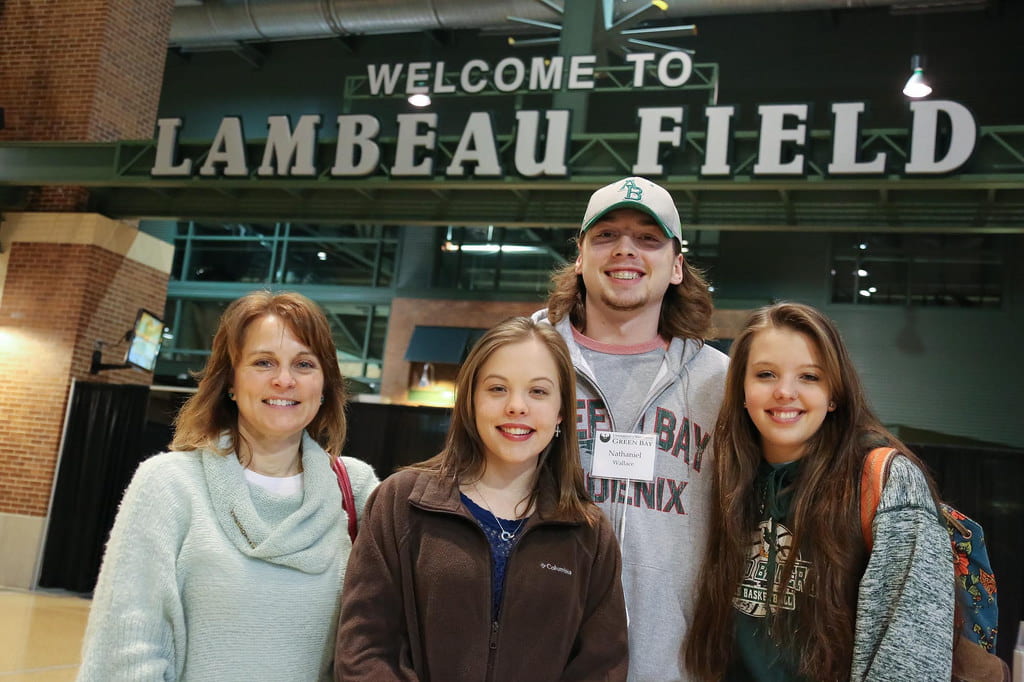A dissection class was the impetus for alumna Samantha Kuba, now a medical examiner

UW-Green Bay Chair of Biology and Human Biology Prof. Dan Meinhardt, writes about a rare opportunity to observe one of his former star students, alumna Samantha Kuba ’13 (Human Biology, Biology) in action, as she continues to develop her UW-Green Bay found-passion in dissection into a career as a medical examiner. His story and insight, follows:
As I get decked out in a disposable apron, surgical mask, and shoe covers, I notice the lack of any noticeable smell. In fact, I sense nothing remarkable in the prep area between a small suite of offices and the morgue. Almost all my experience with human dissection has involved preserved cadavers, which are maintained in a distinct-smelling ethyl alcohol solution (formaldehyde is still used to harden soft tissues in specimens for dissection, but too harmful for long-term preservation). Here I sense nothing but the chilly air-conditioned air and the generic smell of “office.”
The safety equipment I’m being instructed to don would be at home in any light industry setting, like one of the many dairy food facilities back in Green Bay. But as I am led into the morgue, where two recent decedents in body bags lie awaiting their autopsies, all thoughts of food run quickly from my mind.
I am visiting the Pinal County Medical Examiners Office at the invitation of former student, and 2013 UW-Green Bay graduate, Samantha Kuba. Sam, an Appleton native, says she “fell in love” with dissection while earning degrees in Human Biology and Biology (emphases in Health Science and Animal Biology, respectively) at the Green Bay campus. She describes my Comparative Anatomy class as her first real introduction to dissection, and credits two other UW-Green Bay experiences for getting her hired into her current career.
“I participated in the Germany/Plastinarium trip in 2012, and…the cadaver lab my final semester. Out of 245 applicants for a lab-tech position at the Maricopa County (Arizona) Medical Examiner, Sam says, ‘I was chosen entirely because of what I was able to do at GB.'”
The Maricopa County Medical Examiner serves the Phoenix metro area, the nation’s eleventh largest, so Sam’s training made her witness to everything the field could throw at her. After a little over a year and a half, she left Maricopa for a unique opportunity to set up and lead a new facility at nearby Pinal County.
“I basically got to start up my own morgue. I set all the standard operating procedures, organized the work space how I wanted, and trained all staff. I currently run all morgue related operations.” In addition to all this, Sam is working toward certification by the American Board of Medicolegal Death Investigators, and training in forensic photography. I know her hard work is recognized when I see the respect afforded Sam by her supervisor, Pathologist Dr. John Hu. “I am the doc’s eyes in the body, and he trusts that I’m going to alert him to any abnormalities,” Sam tells me.
We’ve kept in touch since Sam left the University, so I was aware of all the impressive things she’s been learning and doing, the amazing stories she can tell, but even that didn’t prepare me for what I saw. It’s not for everyone, so I’ll spare the details, but the anatomist in me was floored by both the speed and precision of Sam’s dissection. It came as no surprise when a newly hired tech told me how lucky she was to learn the job from Sam. As I watched the team finish, I also felt lucky to get the chance to see her work, and proud to have played a small part in her training. In a little more than an hour Sam and her trainee had processed two decedents, and my time at the morgue came to an end.
It may seem ironic to some, biology is the study of life after all, but for specimen-based researchers like me it usually involves working with dead organisms. Often, the field of anatomy is viewed as old fashioned, offering nothing new to learn. But even humans, one of the most studied organisms on the planet, continue to offer new insights. And when it comes to understanding the cause of an individual’s mysterious death, or finding those responsible for a murder, careful dissection is one of the only means to an answer.
Nothing is more rewarding than seeing someone take the training they received at UW-Green Bay and apply it to such important, fulfilling work.
Story and photos submitted by Associate Prof. Dan Meinhardt to the Office of Marketing and University Communication.






